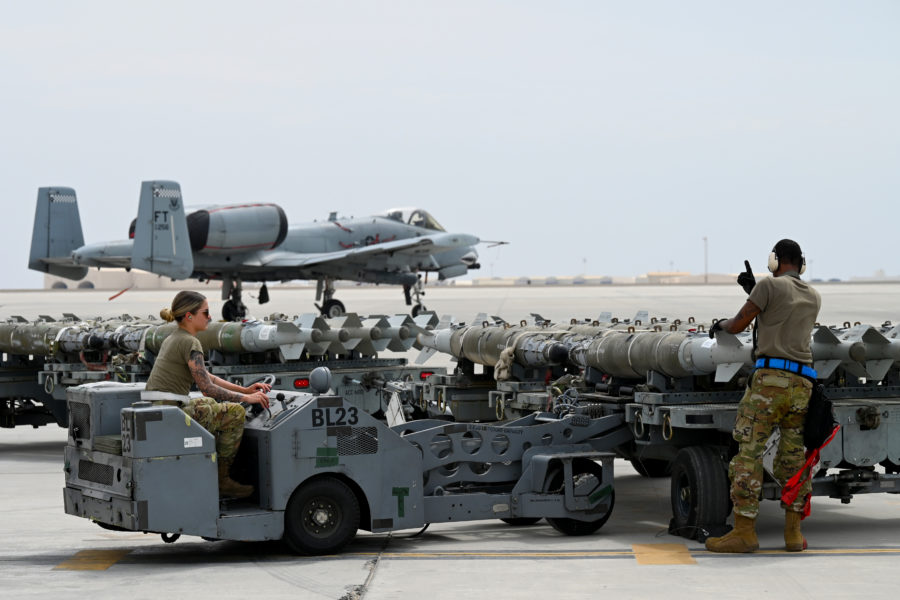Russian aircraft have flown near U.S. forces in Syria almost two dozen times over the past week, as Russian warplanes continue their aggressive maneuvers in the country, according to American officials.
Since March 1, Russian warplanes have violated airspace in Syria that is supposed to be controlled by the U.S. 85 times and conducted 26 armed overflights of U.S. positions, Air Forces Central spokeswoman Capt. Lauren T. Linscott told Air & Space Forces Magazine on April 28.
That marks an uptick of 22 incidents since Air Forces Central began to raise the alarm on April 19 when it counted 63 violations. The number of armed overflights remains unchanged. At times, Russian warplanes have come with 500 feet of U.S. Air Force aircraft.
The Russians are not the only problem. The U.S. has also faced deadly attacks by Iranian-backed militia groups on U.S. facilities in eastern Syria, the most recent of which occurred April 10.
On March 23, a U.S. contractor was killed in Hasakah, Syria in a drone attack. The contractor was a maintainer working on vehicles used by Joint Terminal Attack Controllers (JTACs) supporting the Air Force operations, a U.S. official disclosed.
Two U.S. Air Force F-15E Strike Eagles responded by launching strikes on facilities linked to the Iranian Revolutionary Guard Corps. Iranian-backed forces then launched their own response with more aerial attacks.
The Iranian and Russian threats are increasingly intertwined, a U.S. official said. Iran is providing drones for Russia to use against Ukraine. In turn, Iranian officials said they have been promised Russian fighter jets. U.S. commanders in the region, including Air Forces Central commander Lt. Gen. Alexus G. Grynkewich, have expressed concern about the growing alignment of the two sides.
At the time of the deadly attack, the Air Force was struggling to fill out its capacity requirements of two and a half squadrons. The U.S. has since rushed combat power to the region, accelerating the planned deployment of A-10s in late March, just a few days after the attack. The U.S. also deployed the USS Florida Ohio-class cruise missile submarine to CENTCOM and extended the deployment of the USS George H.W. Bush carrier strike group in the Mediterranean Sea. A U.S. official said those moves were intended to signal to the groups not to strike American personnel any further.
Additionally, a Russian surface-to-air missile from an SA-22 system missed a U.S. MQ-9 in a Nov. 27 incident. The U.S. does not know the intent of Russian forces that fired the missile, according to American officials. The episode is the only publicly disclosed incident of a Russian surface-to-air site firing at a U.S. aircraft in Syria.
“It is unclear if Russian forces were trying to hit the MQ-9,” U.S. Central Command spokesman Col. Joe Buccino told Air & Space Forces Magazine. Buccino said there have been no similar incidents since.
“We recognize that this type of activity by Russia is very inappropriate,” Pentagon Press Secretary Air Force Brig. Gen. Patrick S. Ryder said April 27. “It also is very dangerous. But we’re not seeking to get into a conflict with Russia, nor are we looking to divert attention from why it is that we’re there.”
The U.S. is in Syria to fight ISIS, assisting local partner forces and conducting raids against the militant group. American has around 900 troops in the country. Russia is supporting the regime of Bashar Al-Assad. Ryder declined to say whether the Pentagon believed the recent provocative actions were ordered by Moscow.
Air Forces Central has called the incidents “unsafe and unprofessional,” which risks putting U.S. Airmen and troops at risk. U.S. officials said they believe American forces will conduct themselves professionally and the Air Force follows proper protocols.
U.S. officials say it is unclear exactly what was motivating the Russian pilots but have expressed concern that they may be trying to provoke an incident.
“They’re trying to elicit a reaction,” a U.S. official said. “It’s possible they’re trying to engender an international incident.”
